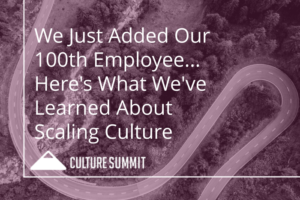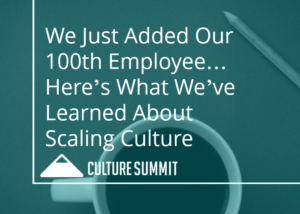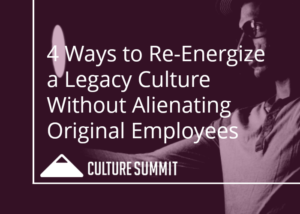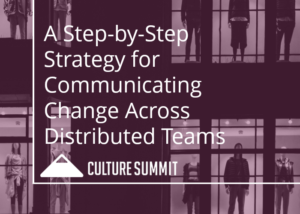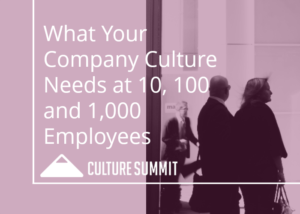7 Employee Engagement Best Practices from the HR Experts at Google
This is a guest post by Mike Sonders, Head of Marketing at Spoke, a simpler, smarter way for HR and People teams to manage employee requests.
Fortune’s annual list of the “Best Companies to Work For” has featured Google every year since 2007. For the last six years, Google held the number-one position.
But Fortune isn’t the only one praising Google as a great place to work. Google’s Glassdoor rating is 4.4 stars—impressive on its own, but even more so considering its based on more than 6,000 employee reviews. Additionally, Glassdoor’s “Employees’ Choice” list of best places to work has featured Google every year since 2009.
Google is a leader in the employee engagement space, and it’s not just because of its high salaries, free chef-prepared lunches, and other quirky—and pricey—benefits. On Glassdoor, Google employees praise things like work-life balance, growth opportunities, and company culture just as frequently as their perks.
If you’re part of an HR team at a small or medium-sized business that’s looking for ways to boost engagement, discover new ideas and exciting opportunities by learning more about the employee engagement practices at Google.
How Google Measures Employee Engagement
Google’s entire approach to business—including how the company drives engagement—revolves around data.
During his tenure as Senior Vice President of People Operations (HR) at Google, Laszlo Bock instituted a long-term research study—named gDNA—focused on developing a scientific understanding of the work experience.
More than just Google’s employee engagement survey, gDNA measures how both the work environment and employees’ individual personalities shape the employee experience. Thousands of randomly selected Google employees complete the survey each year.
One of the earliest findings from gDNA results was that the idea of work-life balance is flawed.
They discovered that there are two types of people: “Segmentors” and “Integrators.” Segmentors are people who are able to go home at the end of the day and completely forget about work. Integrators, on the other hand, struggle to separate work and life.
Less than one-third (31%) of people are Segmentors. The rest are Integrators—people who want to achieve work-life balance but are incapable of making it happen on their own. This data helped Google identify an area with tremendous potential for improving engagement.
If work-life balance is important for keeping employees happy, motivated, and productive—but employees can’t achieve work-life balance on their own—there’s an opportunity to boost engagement by developing policies that enforce work-life balance.
For example, Google’s Dublin office ran a program called “Dublin Goes Dark” that required employees to drop off their devices before leaving the office.
With a team of psychologists, researchers, and data scientists, your HR team could recreate gDNA at your business. But since most SMBs don’t have access to those resources, the better approach is to look at what Google has learned and adopt those practices at your company.
Employee Engagement Practices at Google
In Google’s early days, founders Larry Page and Sergey Brin focused on two things: creating a better way to find information on the internet, and making Google a great place to work.
To find out what makes a company a great place to work, they met with executives at SAS Institute. SAS Institute is one of Fortune’s “Best Companies to Work for Legends,” appearing on the “Best Companies to Work For” list every year since the list began.
What they learned from SAS Institute is that the foundation of building a great place to work is valuing your employees. Or as Jim Goodnight—SAS Institute’s founder and CEO—says: “If you treat people as if they make a difference, they will make a difference.”
The starting point for engagement is making employees feel valued. Here’s how Google shows its employees that they’re valued.
1. Google Keeps People Inspired
A 2017 study conducted by Future Workplace found that employee burnout is currently the largest threat to employee engagement.
One of the biggest causes of employee burnout is lack of control at work. Studies have shown that the most capable employees at a company are often overloaded with work. This leads to incomplete tasks, frequent overtime, and halted innovation—all of which reduce employee control and increase the likelihood of burnout.
Google’s approach to this problem is 20% time. Employees spend up to 20% of their time at work every week on projects that inspire them. With their 20% time, Google employees created Gmail, Google News, AdSense, and many other highly profitable products.
A perk like 20% time inspires employees because it allows them to focus on things they’re passionate about. That inspiration prevents burnout, increasing engagement and decreasing turnover.
Implement 20% time at your company by allowing employees to set an annual goal of their choice. Let them choose anything they’re excited or passionate about. Then, work with managers to give employees the freedom to dedicate one day a week—or one week a month—to working on that project.
Including 20% time in annual goals is important because it gives HR and managers the ability to measure progress and see the outcomes of the initiative.
2. Google Supports Flexibility
Another way to prevent burnout by giving employees more control is to allow for flexibility in work schedules.
Some of Google’s more exotic benefits—like on-site haircuts, massages, bowling alleys, gaming rooms, pools, and playgrounds—aren’t necessarily designed for after-work use. Googlers enjoy those amenities any time they want—even in the middle of the workday.

While most Googlers work some version of a Monday through Friday, 9 a.m. to 5 p.m. schedule, they can vary it up whenever they need to. Work six hours one day and nine the next, go swimming after a morning meeting, or work from home with a sick child—no one cares.
According to Prasad Setty, VP of People Operations at Google, one of the company’s core tenants is “if you give people freedom, they will amaze you.”
But giving their employees freedom and flexibility isn’t a matter of blind trust. Google only hires ambitious people—the types of people who do their work whether someone’s watching or not. In fact, the company is well-known for its lengthy, detailed, and thorough hiring process.
There are plenty of ways to support flexibility at your company. Allow employees to work from home when needed, adopt flex schedules, increase the amount of personal time employees get each year, or allow employees to take their personal time in hours—not days.
And remember that people are most productive in the morning before lunch. If flex time means people take the afternoon off for appointments or errands, it’s probably not as much of a blow to productivity as leadership may imagine at first.
3. Google Promotes Diversity
In 2015, Google expanded its 20%-time perk to create Diversity Core—a program that allows employees to allocate their time to diversity projects and initiatives.
Employees who participate in Diversity Core work on projects that raise the visibility of women in technology jobs and encourage more Hispanics to apply to work at Google, among many others.
According to data from Google, in 2014—before implementing Diversity Core—the company’s gender split in technical roles was 17% female and 83% male. As of the beginning of 2017, the number of females in technical roles at Google was at 20%.
Additionally, Google locations in the U.S. employed 5% more Asians and 1% more Hispanics at the beginning of 2017 than in 2014. If these numbers seem small, remember that Google employs more than 70,000 people; even a mere 1% increase is more than 700 people.

Implement a program like Diversity Core at your company by allowing employees to set 20% time goals toward projects that promote diversity and inclusion in the workplace, and consider adopting some of Google’s other practices:
- Require all employees and managers to attend training on unconscious bias.
- Offer benefits that support the needs of people in nontraditional families.
- Review salaries to make sure there are no discrepancies in pay between different genders and races.
Google Employee Engagement Case Study
When analyzing data from gDNA results, Google’s People Analytics team noticed that fewer female software engineers were getting promoted than males. The problem, they found, was with their self-nominating approach to promotions.
At Google, software engineers nominate themselves for promotion when they feel they’re ready to take on more responsibility. The problem wasn’t that managers were promoting more men; it was that fewer women were nominating themselves for promotions.
To fix the problem, a senior leader at Google shared the data with Google employees, and HR teams encouraged managers to look for employees who were ready for promotion. Over time, the promotion rates for men and women software engineers equalized.
4. Google Listens, Responds, and Adapts
The gDNA study is just one way that Google collects feedback from its employees:
- Employees use a tool called Google Moderator—another outcome of 20% time—to ask questions and vote on others’ questions they want answered.
- Every Friday, the company holds an all-hands meeting where company leaders respond to the most popular questions of the week.
- Leaders use a charting tool called Google-O-Meter to measure the popularity of different employee suggestions.
- Leaders also schedule “Fixits” to solve big, urgent problems. Fixits are 24-hour sprints where teams focus 100% on finding solutions to specific problems.
There are plenty of ways for HR teams at SMBs to solicit employee feedback: engagement surveys, pulse surveys, anonymous forms, or even just a basic pen-and-paper suggestion box.
But remember that the only way to benefit from giving employees a voice is to respond and react to their suggestions. If you don’t have leadership buy-in on making changes, it’s probably not worth asking for feedback. Doing so will make people less likely to make suggestions in the future.
Google Employee Engagement Case Study
In its early days, Google founders Page and Brin wondered if a flat structure—one without managers—was better than a traditional workplace hierarchy. Eventually, the company turned to data to answer that question, launching a study called Project Oxygen.
Project Oxygen researchers gathered feedback data from employee surveys. They used that feedback data to create a baseline for determining management quality, and then they used that baseline to identify managers of the highest and lowest quality.
Next, they looked at survey data specifically for their highest- and lowest-quality managers. What they discovered was that managers identified as the highest quality had the lowest turnover and happiest teams.
By collecting employee feedback, Google was able to determine that a flat hierarchy wasn’t the best way to improve engagement. Additionally, they discovered the specific behaviors that their highest-quality managers exhibited, using that information to create new management training programs.
5. Google Encourages Development
There are a lot of different ways for businesses to encourage professional development:
- Offer a professional development stipend.
- Form a mentorship program.
- Provide PTO specifically for time-off related to learning and development.
- Have an on-site library of books selected by employees and leaders.
- Reimburse employees for tuition costs.
Google has its own unique way of encouraging professional development: CareerGuru. CareerGuru provides employees with access to company leaders who explain—in great detail—what it’s like to work in different roles within the company.
This level of career coaching helps employees find roles they might want to move into one day in the future and learn what education and experience they need to qualify.
To recreate CareerGuru at your company, find managers and executives interested in offering occasional career coaching, and set up sessions for employees to meet with leaders to learn more about different roles. If confidentiality is a concern, handle all scheduling within HR, and set up one on ones instead of group meetings.
6. Google Creates a Culture of Empathy
Data doesn’t always have the answers. That’s a lesson Google learned during Project Aristotle—the company’s quest to determine the composition of the perfect team.
Using a decade’s worth of data collected about Googlers—covering everything from their educational and career backgrounds to their interests and eating habits—researchers and data scientists attempted to find patterns among Google’s highest-performing teams.
They couldn’t.
The conclusion they ultimately came to was that the perfect team had nothing to do with any qualities of the people on that team. The statisticians couldn’t find patterns. The data just didn’t contain the answers they were looking for.
So the team took a different approach: they observed high- and low-performing teams to look for consistencies in how the teams interacted and ran meetings. The discovered that members of the highest-performing teams felt safe speaking up and sharing their ideas.
Great teams trust and respect each other, providing all members with not only a voice, but also the confidence to share that voice with others.
Here’s how Charles Duhigg summarizes Project Aristotle’s findings in his piece for The New York Times:
What Project Aristotle has taught people within Google is that no one wants to put on a ‘‘work face’’ when they get to the office. No one wants to leave part of their personality and inner life at home. But to be fully present at work, to feel ‘‘psychologically safe,’’ we must know that we can be free enough, sometimes, to share the things that scare us without fear of recriminations. We must be able to talk about what is messy or sad, to have hard conversations with colleagues who are driving us crazy.
Emotional intelligence training is one way for HR teams at SMBs to promote trust and respect in the office. It’s also important to remember that a company’s culture starts at the top. Encourage senior leaders to be more open and honest with employees—and to encourage their reports to do the same.
7. Google Offers Unique Benefits
An article about Google just wouldn’t be complete without covering the company’s unique benefits. But many discussions of Google’s benefits focus on the wrong thing—they focus on what the benefits are and not why Google offers them.
For example, in Google’s early days, Page and Brin noticed that young software engineers were really bad about washing their clothes. This led to the company’s on-site laundry perk. No one sat down to brainstorm benefits and thought, “I bet this perk will make people want to work here.” They were simply fulfilling a need.
When putting together the benefits package for SMBs, consider what you know about company employees, and use that information to design unique benefits:
- If many employees have young children, consider offering childcare reimbursement instead of/in addition to tuition reimbursement.
- If many employees are recent college graduates, consider offering student loan payment matching instead of/in addition to 401k matching.
- If many employees are nearing retirement, consider allowing them to invest their professional development funds into their retirement accounts.
If you don’t know enough about employees to know what benefits they need, collect information from managers, or include demographic questions in engagement surveys.
Building Your Own Employee Engagement Practices
Laszlo Bock offers the following advice for HR teams looking to measure engagement and find innovative ways to improve it:
- Determine your biggest issues. Ideally, you’ll get this information from your employees.
- Use surveys to collect employee feedback on how to improve or resolve the issues.
- Tell people what you learned and how you plan to resolve the issues.
- Experiment with solutions.
When experimenting, Google recommends that you “treat HR interventions like a medical researcher treats a drug trial: have a treatment group and an equivalent control group, hypotheses, a data collection period, an analysis comparing groups, and quantifiable outcomes.”
Even if your plan is to simply recreate Google’s learnings at your company, it’s important to test the changes first and measure the outcomes. It’s a lot of work, but the engagement benefits will make the hard work well worth it in the end.

